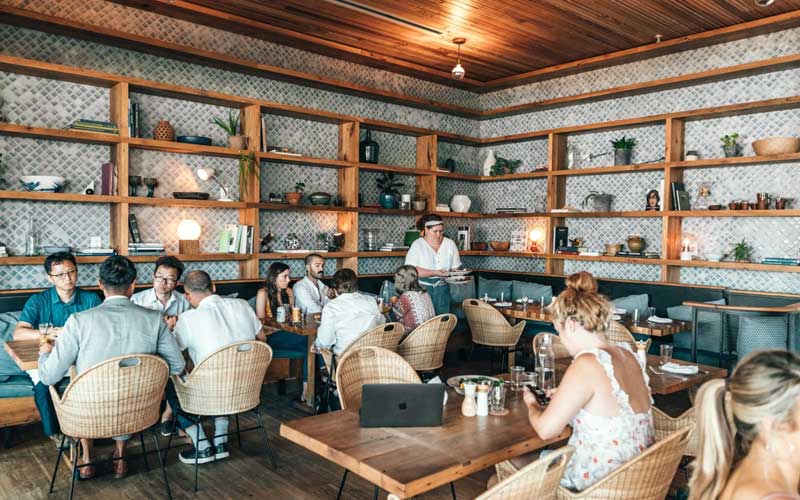
Restaurant staff are the backbone of the industry, and with the right team behind you, it can be easier for your business to thrive. However, finding (and holding on to) the best people who share your passion and are committed to their role is a common stumbling block – even for the most seasoned restaurant owner.
For new restauranteurs, starting from scratch and recruiting a new team can be daunting, particularly in a saturated market. To help, we’ve compiled the best tips and tricks from across the industry to help you hire, train and (most importantly) retain your team.
Let’s dive in.
- Challenges in restaurant staffing
- Recruiting and employment: labor laws
- Restaurant staff roles and responsibilities
- Restaurant staff recruitment
- How to structure the interview process
- How to write a restaurant employee handbook
- How to onboard new restaurant staff
- How to make a schedule for your restaurant staff
- How to retain restaurant staff
Free Hospitality Recruitment Guide
Get expert industry tips for a complete employee management process in this free guide: How to Find, Hire & Retain Your Dream Team.
Challenges in restaurant staffing
When it comes to hospitality staffing, two major issues are impacting the industry:
- High staff turnover rates have plagued the industry for years. According to the U.S. Bureau of Labor Statistics, the annual average employee turnover rate across all industries is 12-15%. Yet, some hospitality businesses, such as quick-service restaurants, routinely experience 150% annual staff turnover.
- Staff shortages are impacting restaurants in the wake of the Covid-19 pandemic. Restaurants across the US and Canada are battling a staff shortage crisis, with restaurants across both countries finding it hard to fill thousands of vacant job roles.
Recruiting and employment: labor laws
Before you get the recruitment ball rolling, it’s essential to familiarize yourself with the different labor laws in your state.
United States
Wages
Labor laws in the US are set out by the federal government, and these apply to all states. Individual states can also set their own labour laws, such as minimum wage laws. However, if the state’s minimum wage law is lower than the federal minimum wage, restaurants must pay the higher wage.
The federal minimum wage is $7.25 per hour; however, employees under the age of 20 can be paid at least $4.25 an hour during the first 90 days of their employment.
The federal minimum wage also stipulates that tips may also be considered part of wages. For employees that earn tips, such as restaurant waitstaff, tips can be included in the hourly wage; however, the restaurant must not pay tipped employees less than $2.13 minimum per hour. They must also ensure that the tips add up to be equal to or above the minimum wage.
It’s also important to check the minimum wage laws in your state. California, for example, doesn’t allow a lower minimum wage for tipped employees; instead, restaurants must pay tipped employees at least the state minimum wage of $11 per hour.
If an employee works overtime (any additional time worked over 40 hours in one week), they are entitled to a rate of at least 1.5 times their standard hourly rate. Uniforms or other items that are deemed essential by the restaurant also can’t be included as part of wages, and restaurants can’t include these when meeting the criteria for paying minimum wage or overtime.
Equal rights
It’s illegal to discriminate against a job applicant or an employee because of the person’s race, color, religion, sex, national origin, age, disability or genetic information. Restaurants must ensure they comply with the following when hiring and employing staff.
- You must display a poster at your business that describes the federal employment discrimination laws.
- Male and female restaurant employees who perform the same work must receive equal pay.
- You must retain any employment records, such as applications, personnel, payroll, and benefits records.
- You may be required to provide reasonable changes to the restaurant because of an applicant’s or employee’s religious beliefs or disability.
- You can’t use employment policies or practices (unless they are related to the job and necessary for the operation of your business) that have a negative impact on applicants or employees of a particular race, color, religion, sex or national origin or those with disabilities.
I-9: Employees’ right to work
An I-9 form is used to verify the identity of all new hires (both citizens and non-citizens) to ensure they are legally entitled to hold a job in the US. Under federal law, restaurants must fill out an I-9 form for every employee at the start of their employment.
It’s crucial to ensure all information on an employee’s I-9 is correct before submitting, as any mistakes can result in restaurants being issued with fines and penalties even if they never hired someone unauthorized to work in the country. Fines for a single error on an I-9 form can range from $216 to $2,156.
Health and safety
The Occupational Safety and Health Administration (OSHA) outlines several health and safety labor laws that restaurants need to follow.
- Display posters from the Department of Labor or their state labor department to inform employees of their protections and rights.
- Ensure the restaurant is free from hazards that are likely to cause death or serious physical harm to employees.
- Employees must have easy access to a first aid kit.
- Provide training, e.g. fire safety, to avoid and prevent accidents in the restaurant.
- Provide necessary protective equipment and materials to all restaurant workers.
Canada
In Canada, labor laws are not determined at the federal level. Instead, each province and state has its own employment standards legislation that sets out the minimum legal requirements that an employer must follow, such as minimum wage, statutory holidays, annual leave entitlements etc.
Please visit your province or territory website to understand which labor laws you should adhere to in your restaurant.
- Alberta – employment standards
- British Columbia – information for employers
- Manitoba – human resources for employers
- New Brunswick – employment standards
- Newfoundland and Labrador – information for employers
- Northwest Territories – employment standards
- Nova Scotia – employment rights
- Nunavut – labour standards
- Ontario – employment standards
- Prince Edward Island – employment standards
- Quebec – labour standards
- Saskatchewan – labour standards
- Yukon – employment standards

Restaurant staff: roles and responsibilities
Every restaurant is different and will need its own unique mix of staff, both front-of-house (FOH) and back-of-house (BOH), to keep it running smoothly.
While you might not need all of these roles in your restaurant, here are some of the most common roles and responsibilities for restaurant staff.
Front-of-house staff
- Host – greets customers as they enter the venue, guides them to their seats and coordinates reservations.
- Server/waitstaff – responsible for looking after customers, giving out the menu, taking orders, ensuring drinks are topped up, bringing out dishes and taking payment.
- Bartender – takes orders at the bar and prepares drinks. Should have a broad knowledge of the available beverages.
- Barback – responsible for keeping the bar running smoothly, for example, re-stocking fridges and glasses, replenishing garnishes etc.
- Busser – responsible for table set-up and clearing tables when guests have left.
- Runner – works closely with waitstaff and helps bring food to tables.
- Barista – responsible for making all coffee orders. Should have a broad knowledge of the available drinks.
- Cashier – takes orders and payments at the counter.
Back-of-house staff
- Head chef – manages the entire kitchen and its staff, responsible for the menu, preparing dishes and training new chefs. They are also responsible for managing inventory.
- Sous chef – assists the chef in cooking meals and is usually responsible for their station in the kitchen.
- Prep cook – assists the head and sous chefs by preparing the ingredients ready for cooking.
- Line cook – assigned to a certain section of the kitchen, such as the grill, and are responsible for preparing orders that are relevant to their station.
- Dishwasher – responsible for cleaning dishes and utensils and manning the dishwasher.
Management
- Restaurant manager – responsible for day-to-day operations, manages employees, marketing, recruitment, staff scheduling and more.
- Assistant manager – assists the restaurant manager.
Restaurant staff recruitment
If you can nail your recruitment process from the get-go, your training program and retention strategies should technically be a walk in the park. However, as we all know, finding the right staff is often easier said than done.
What to include in a restaurant job description
The first step in the hospitality recruitment process is to list all the information you’ll need to create a compelling job advert. This should include:
- Job title
- A short description of your business
- A brief description of the role you’re hiring for
- A list of tasks and responsibilities
- A list of prior skills, qualifications and experience a candidate should have
- Details about the position, e.g. full-time, part-time, casual, salary and leave entitlements
Where to post job advertisements
When you have a job opening in your venue, the standard practice is to stick an ad in the window and hope for the best. While this method is tried and tested, it’s not always the best way to attract top talent.
If you’re struggling for applicants, try advertising your job on one or more of the following:
- Social media channels, mainly LinkedIn, Facebook and Instagram
- Job portals such as Indeed
- Recruitment agency
- Ask staff, friends and family if they can refer someone who’d be a good fit
How to structure the interview process
While you’ll be recruiting for a wide range of different roles, each interview you conduct should roughly follow the same process.
- Short introduction where you’ll briefly introduce yourself, your role, some background about the business and a brief description of the position you’re hiring for.
- Questions from the interviewer(s) to the candidate.
- Opportunity for the candidate to ask questions.
- Quick wrap-up to bring the interview to a close. You should outline any next steps, for example, a second interview or trial shift and also let the candidate know a rough timeframe for when you’ll get back to them.
Remember: to avoid staff turnover further down the line, potential employees must understand what to expect from the role. During the interview, be honest about your expectations for the role, what your team is like and what it’s like to work at your venue.

What questions to ask in the interview
Each role you’re hiring for will require a few role-specific questions; however, there are several questions you should ask every candidate, no matter their role, to get a decent understanding of their personality and aptitude.
Before you sit down with your chosen candidates, ask yourself the following questions:
- Who is your ideal person for the role?
- What skills should they have?
- What qualities will they bring to your team?
From there, you can plan how you will conduct the interview and the type of questions you will ask.
Cover a range of personal and professional questions to get an idea of how well the person will fit into your team and if they’ll excel at the job. Here are some questions to consider:
- Tell me about yourself
- Why do you want to work here?
- Tell me about your experience that’s relevant to this role
- What did you like/ dislike most about your previous job?
- Why do you want to work here?
- How would you deal with a customer complaint?
- Tell me about a time when you…
Ask an unusual question to sieve through talent
Try including an unexpected question to test your candidate’s quick thinking and gauge their personality. These questions don’t necessarily have a right or wrong answer; they aim to provoke a more honest, insightful (and fun) response.
Here is a collection of questions for inspiration that companies big & small from across the world ask their candidates to spice up their interview process.
- If you could have any superhero power, what power would you have and why?
- If you could compare yourself with any animal, which would it be and why?
- How do you think people would communicate in a perfect world?
- What advice would you give to your previous boss if you could?
- How would you sell hot chocolate in Florida in the summer?
- If I gave you $50,000 to start your own business, what business would you start?
- Describe the purpose of this job to someone from another planet.
Remember: the goal of asking a strange interview question is to make finding the best person for the job easier. Someone startled by left-field questions or struggles to answer may not be the best fit for dealing with unhappy customers or unusual customer requests.
Red flags to look out for during the interview process
While nerves are a normal part of the interview process and shouldn’t be looked down upon, there are some red flags that you should look out for to ensure you hire the right candidate.
- Being late to the interview
- Struggles to give examples of past work or experience
- Lack of eye contact
- Their CV doesn’t match what they’re saying
- Lack of enthusiasm
- Being overly negative about past employers
How to write a restaurant job offer letter
Once you’ve found the right candidate for the role, the next step is to tell them the good news and provide them with an official job offer letter.
Restaurant job offer letters don’t have to be too long or complicated, but there are a few key things you need to include.
- Date of the offer
- Confirmation of the job role they applied for
- Details of the type of employment (e.g. full-time) and salary
- Expected start date
- Offer acceptance due date
- Your signature and date
- Next steps, e.g. signing of employment contract, uniform collection, training schedule
Once you’ve sent the job offer letter to your chosen candidate, you should expect to hear back from them within the next few days, either accepting or rejecting the role. If the candidate accepts, you can prepare an employment contract for them to sign to make things official.
How to write a restaurant employee handbook
An employee handbook is an excellent resource for building a positive workplace culture. It provides staff and managers with a clear set of guidelines for procedures and behavior so everyone is on the same page. It also acts as a reference point, so staff know the ins and outs of your venue and what’s expected of them.
Your employee handbook should include:
- Introduction
- Mission statement & core values
- Restaurant structure
- Employee benefits
- Code of conduct
- Dress code policy
- Leave policy and procedures
- Safety protocols
- Front-of-house & back-of-house operations
- Scheduling process
- Tech how-to guide
- Complaints procedure
How to onboard new restaurant staff
Training is crucial to an employee’s onboarding process and will set your team up for success.
Before we dive into the specific areas of training for FOH and BOH staff, there are a few key areas all new staff should be introduced to on their first day.
- Their day-to-day duties, tasks and responsibilities
- Your menu
- Upcoming and regular events
- Daily specials
- Health, safety and hygiene procedures
- Fire safety guidelines and evacuation procedures
What FOH training should be provided?
Ask new FOH staff to come in during a quiet period or when you’re closed so you can show them around the restaurant without getting in the way of customers.
You should then train them on the following:
- How to use your POS system, with a focus on taking orders and payments
- FOH tour, e.g. dining room, counter, bar etc.
- Where tablecloths, cutlery, glassware and crockery are stored
- Table planning, setting and seating process
- Meet and greet procedures
- How to handle customer complaints
- Upselling tips
- Cleaning procedures
- Ensure new hires are up to date with any mandatory training and licensing requirements
Tip: While everyone will receive thorough training on their roles, it also makes sense to cross-train certain employees, so you’re never left short on a busy night or if someone is sick.

What BOH training should be provided?
Every kitchen is different; depending on how many BOH staff you have and how large your kitchen is, you’ll need to approach training differently.
However, there are several areas all BOH staff should be trained on.
- BOH tour, e.g. store rooms, prep area, kitchen, fridge, freezer etc.
- How to use your POS system, with a focus on inventory management and stock takes
- Kitchen equipment training
- Stocktake procedures and how to record wastage
- How to receive deliveries
- What uniform to wear
- Food allergy procedures
- Potential hazards
- Cleaning procedures
How to make a schedule for restaurant staff
From managing personalities to ensuring you don’t schedule too many (or too few) staff and juggling leave requests creating a productive staff roster can be the key to an efficient work environment.
Follow these steps to create a staff schedule for your restaurant.
- Set regular time aside each week/fortnight/month to plan and write your rota
- Be strategic and schedule your staff based on their strengths, e.g. best upsellers on busy evenings and most efficient staff during peak periods.
- Share the good shifts fairly amongst your team.
- Schedule your busiest shifts first, so you know your best employees will be available.
- Avoid back-to-back shifts where possible. Sometimes they’re unavoidable during busy periods, but you should give your employees enough notice if they’re working double.
- Ensure staff notify you of any shift swaps so you can amend the rota accordingly and are aware of who’s on each shift
- Give staff two consecutive days off when possible.
- Use employee scheduling software to keep track of rotas, cost shifts and give employees visibility and the easy ability to swap shifts.
How to retain restaurant staff
Creating a positive and supportive work environment will empower staff to give their all, remain motivated, and be less likely to leave.
“Train people well enough so they can leave. Treat them well enough, so they don’t want to” – Richard Branson.
Build an enviable workplace culture
Take the time to sit down with your team and ask them what they love about working at your venue and what could be improved. You can then ensure their concerns are addressed and implement initiatives to motivate and encourage team building.
- Respect employees’ time. Implement a structured roster, with regular hours for each employee that rarely change, so your team can plan their personal schedules more effectively.
- Make life easy for staff. Give staff adequate breaks and offer free or discounted meals while on shift.
- Acknowledge and manage stress. Take time to manage stress in the workplace and make it easy for staff to raise concerns.
- Don’t rush recruitment. Take your time to find the right people who will work well with your team and fit into your culture.
- Get your team together. Run social events and encourage your team to join in.
Employee management strategies
Taking the time to set up employee management strategies for your restaurant is the best way to ensure a great work environment for your team.
Consider implementing some of the following strategies to keep your team motivated:
- Set clear KPIs – key performance indicators (KPIs) are a great way to motivate staff by setting achievable goals, incentivising them to consistently do their best and holding them accountable.
- Rewards – when team members hit their targets, reward them for their effort. This will motivate them to do well in the future and shows your appreciation.
- Hold regular meetings – check in with your team to share insights on the business, give feedback on their performance and see if they have any concerns or questions.
- Training sessions – hold regular training sessions throughout the year to keep your employees up-to-date with new equipment, rules and regulations and to cross-train on each other’s roles.
- Team building – Organize activities to keep your team excited and motivated. This could include a BBQ at the beach, team sports or evening drinks.
- Ask their opinion – ask your team what works well and what needs improving to make their day-to-day life easier.
Happy staff make happy customers
Your team will be the backbone of your venue, and well-trained, happy employees will go above and beyond to give excellent service.
If you can nail your interview process, provide detailed and regular training, set achievable KPIs and motivate your team with rewards, you can minimize your staff turnover rate and build a dependable team who love their jobs. And when your team are happy, their passion and enthusiasm will shine through – ensuring your customers receive the best possible service and experience.
Free Hospitality Recruitment Guide
Get expert industry tips for a complete employee management process in this free guide: How to Find, Hire & Retain Your Dream Team.

News you care about. Tips you can use.
Everything your business needs to grow, delivered straight to your inbox.


